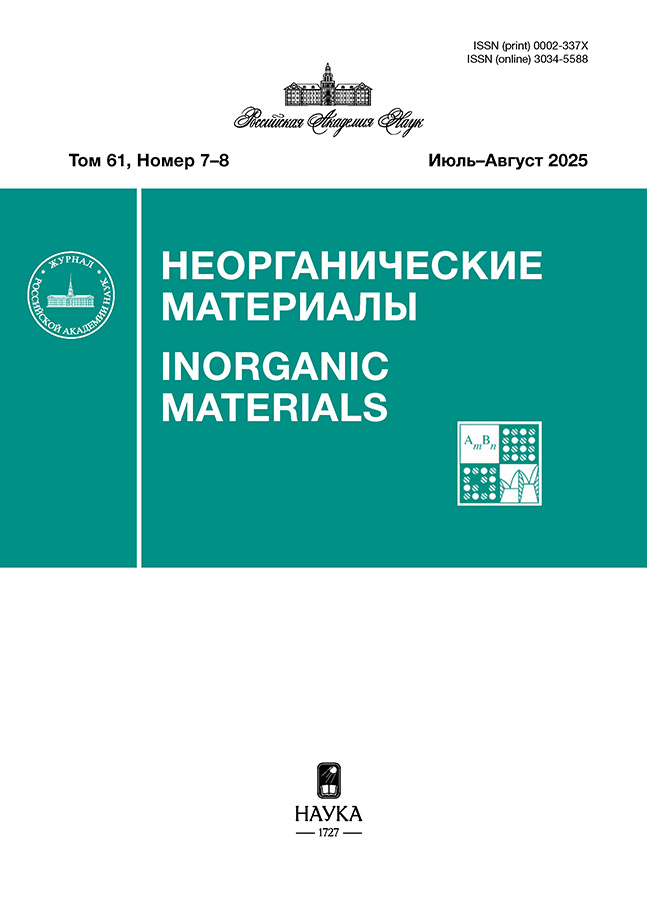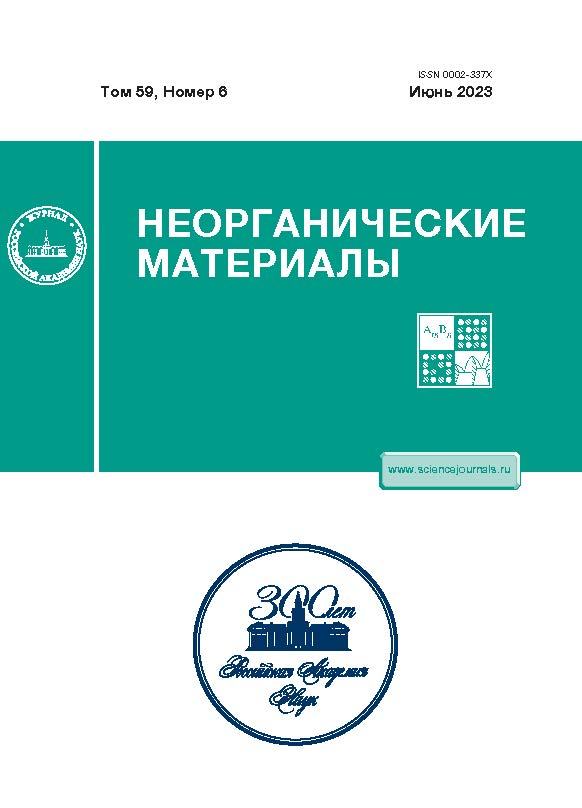Том 59, № 6 (2023)
Статьи
Кинетика атомного упорядочения сплава Cu–56 ат. % Au при температуре 250°С
Аннотация
Проведено исследование кинетики фазового превращения беспорядок → порядок (A1 → L10) в нестехиометрическом сплаве Cu–56 ат. % Au при температуре 250°C. Исходное разупорядоченное состояние формировали либо закалкой образцов от высокой температуры, либо сильной пластической деформацией. Установлено, что скорость атомного упорядочения закаленного сплава чрезвычайно мала и превращение заканчивается приблизительно через 2 мес. отжига при температуре 250°C. Скорость атомного упорядочения предварительно деформированных образцов еще ниже. Обнаружено, что как в закаленном, так и в упорядоченном состояниях кристаллическая решетка исследуемого сплава немного больше по сравнению с эквиатомным сплавом. Установлено, что вне зависимости от исходного состояния образцов их микротвердость в процессе атомного упорядочения сначала возрастает, а затем снижается. Впервые показано, что удельное электросопротивление сплава Cu–56Au в хорошо упорядоченном состоянии составляет ρ = 7.04 × 10–8 Ом м, что намного ниже, чем считалось ранее. На основе полученных данных построена зависимость соотношения фаз (порядок/беспорядок) на различных этапах отжига.
 589-596
589-596


Образование наночастиц диборида тантала при взаимодействии аморфного бора с танталом в ионных расплавах
Аннотация
Исследовано взаимодействие активированного механохимическим способом порошка тантала с аморфным бором, взятых в мольном соотношении 1 : 2, в ионных расплавах солей различного состава при температурах 1023 и 1073 K в атмосфере аргона. Показано, что применение ионных расплавов позволяет получать близкие к сферическим частицы TaB2 (пр. гр. P6/mmm) со средним диаметром ~70 нм, с параметрами элементарной ячейки a = 0.3077–0.3090 нм и с = 0.3227–0.3245 нм.
 597-602
597-602


Исследование боридов вольфрама, полученных из вольфрамсодержащего концентрата при воздействии СВЧ-плазмой
Аннотация
Исследованы структуры боридов вольфрама, полученных из минерального вольфрамсодержащего концентрата, на экспериментальной установке электродуговой СВЧ-плазмы. Разработана схема установки с генератором СВЧ-поля, плазмотроном косвенного действия и реакционной камерой. Рассмотрены некоторые вопросы позиционирования плазмотрона на волноводной камере и формирования СВЧ-потока плазмы в зоне конфузора с последующим выходом потока в зону концентратора. Дано описание процессов, протекающих при плазмохимическом синтезе боридов вольфрама. Изложен способ изготовления и подготовки смеси на основе многокомпонентного минерального концентрата – шеелита Дальневосточного региона. Приведены результаты анализа химико-физических свойств боридов вольфрама, полученных при локальном высокоэнергетическом воздействии потоком плазмы с удельной мощностью 10–100 кВт/см2. В ходе исследований получены соединения WB, WB2, W2В и W2В5. Обоснована перспективность применения плазменных технологий для формирования тугоплавких соединений на основе бора и вольфрама из шеелитового концентрата.
 603-609
603-609


Морфология поверхности, фазовый состав и локальные электрические свойства пленок фуллерита с разной атомной долей олова и висмута
Аннотация
Методами сканирующей зондовой и электронной микроскопии, рентгеноспектрального и рентгенофазового анализа, КР- и Фурье-спектроскопии исследованы морфология поверхности, элементный и фазовый составы, локальные электрические свойства пленок фуллерита с разной атомной долей олова и висмута. Пленки получены из совмещенного атомно-молекулярного потока методом резистивного испарения в вакууме на подложках из окисленного монокристаллического кремния. Толщина пленок составила 1 мкм. Установлено, что свежесконденсированные пленки состоят из частиц разных размеров – от 30 до 200 нм, на рентгенограммах наблюдаются отражения фуллерита С60 с гранецентрированной кубической решеткой, находящейся в напряженном состоянии из-за внедрения атомов примеси, а также отражения чистых олова и висмута. С помощью оптической спектроскопии выявлено образование комплексов фуллеренов с атомами Sn и Bi. Электросиловая микроскопия показала значительное уменьшение поверхностного потенциала пленок фуллерита, легированных оловом и висмутом, и неоднородное распределение градиента поверхностной емкости.
 610-617
610-617


Кварцевый световод на основе изотопно обогащенного 28SiO2
Аннотация
Методом MCVD из высокочистого изотопно обогащенного тетрахлорида кремния-28 изготовлена преформа кварцевого световода со светоотражающей оболочкой и сердцевиной на основе изотопно обогащенного диоксида кремния-28. Измерен профиль показателя преломления полученной преформы. Методом вторичной ионной масс-спектрометрии охарактеризован профиль распределения изотопов кремния по сечению преформы: содержание 28Si в составе кремния находится на уровне 99.9%. Из преформы вытянут волоконный световод со светоотражающей оболочкой и сердцевиной на основе изотопно обогащенного диоксида кремния-28: оптические потери в световоде в диапазоне длин волн 900–1700 нм составляют 1–2 дБ/км. Измерен уровень радиационно-наведенных потерь в кварцевом световоде с сердцевиной из изотопно обогащенного 28SiO2 при мощности дозы 3.2 Гр/с на длине волны 1.31 и 1.55 мкм.
 618-623
618-623


Монолитные структуры Ni/LiNbO3 с интерфейсным магнитоэлектрическим эффектом
Аннотация
Методом ионно-лучевого распыления–осаждения получены слоистые структуры в виде субмикронных слоев никеля на монокристаллических подложках сегнетоэлектрика ниобата лития LiNbO3. В данных структурах при комнатной температуре наблюдается интерфейсный магнитоэлектрический эффект, максимальная величина которого в поперечной конфигурации магнитного и электрического полей составляет 108, а в продольной – 4 мВ/А. На основании анализа механических деформаций сделан вывод о значительном вкладе интерфейса в магнитоэлектрическое взаимодействие в полученных структурах Ni/LiNbO3. Данные материалы могут найти применение при разработке устройств пьезотехники, а также акустической, оптической и спин-волновой электроники.
 624-630
624-630


Кристаллическая структура и термодинамические свойства титанатов RGaTi2O7 (R = Sm, Ho, Tm, Yb)
Аннотация
Твердофазным синтезом из смесей оксидов Ga2O3, TiO2 и R2O3 обжигом на воздухе при 1273 и 1573 K получены замещенные титанаты RGaTi2O7 (R = Sm, Ho, Tm и Yb). По данным рентгеновской дифракции определена их кристаллическая структура. Методом дифференциальной сканирующей калориметрии исследовано влияние температуры (320–1000 K) на теплоемкость синтезированных соединений. По экспериментальным данным Cp = f(T) рассчитаны основные термодинамические функции и методом групповых вкладов рассчитаны стандартные значения энтальпии и энергии Гиббса образования RGaTi2O7 (R = Sm, Ho, Tm и Yb).
 631-637
631-637


Синтез и исследование катодного материала для натрий-ионного аккумулятора на основе композита фосфата натрия-ванадия(III) и терморасширенного графита
Аннотация
В настоящей работе апробирован усовершенствованный твердофазный синтез Na3V2(PO4)3 со структурой суперионного проводника NASICON и размерами частиц 0.5–4.5 мкм на основе распылительной сушки водного раствора прекурсоров с последующим отжигом в атмосфере азота. Максимальная удельная емкость для композита из полученого Na3V2(PO4)3 и терморасширеного графита составляет 117.00 мАч/г при скорости заряда и разряда С/20 и уменьшается до 76.73 мАч/г после 200 циклов зарядно-разрядных ресурсных испытаний при скорости заряда и разряда 1С. Величина кажущегося коэффициент а диффузии иона натрия в твердой фазе композита Na3V2(PO4)3/С для процесса де- и интеркаляции составляет 5.87 × 10–11 и 4.60 × 10–11 см2/c соответственно.
 638-645
638-645


Получение и изучение строения и поведения при нагревании ванадатов кальция, лантаноидов и циркония со структурой циркона
Аннотация
Методом соосаждения получены простые LnVO4 и тройные CaLnZr(VO4)3 (Ln = Nd, Sm, Eu, Gd, Dy, Yb) ортованадаты лантаноидов; твердый раствор La0.3Nd0.5Sm0.1Eu0.1VO4, моделирующий состав фракции лантаноидов РАО, имеющие структурный тип циркона (пр. гр. I41/amd); а также LaVO4, кристаллизующийся в структурном типе монацита. Параметры элементарных ячеек монотонно возрастают с ростом ионного радиуса лантаноида. Колебательные спектры в средней и дальней ИК-областях свидетельствуют о понижении симметрии соединений по сравнению с классическим цирконом. Фазовая стабильность полученных соединений сохраняется до 900°C. Средние коэффициенты теплового расширения варьируются в интервале (6–11) × 10–6 K–1.
 646-653
646-653


Золь–гель-синтез и исследование влияния добавок Y2O3 и Eu2O3 на формирование алюмомагнезиальной шпинели
Аннотация
Синтезирована алюмомагнезиальная шпинель с использованием золь–гель-метода. Изучено влияние оксидов европия и иттрия на синтез и кинетику формирования алюмомагнезиальной шпинели при термической обработке в интервале температур 500–1000°C. Методами рентгенофазового и химического анализов установлено, что формирование алюмомагнезиальной шпинели происходит при температуре 1000°C и выдержке 240 мин ксерогеля, полученного на основе смеси соединений Al(NO3)3 + Mg(NO3)2 при соотношении 2 : 1 соответственно. Полученный продукт содержит примесь несвязанного MgO. Добавка минерализующего оксида Eu2O3 в количестве 1.5 мас. % от общей массы исходной смеси при выдержке 240 мин снижает температуру максимального формирования шпинели до 900°C. В случае Y2O3 для максимального формирования шпинели при этой же температуре требуется добавка в количестве 3 мас. %.
 654-661
654-661


Двухслойные световоды на основе высокочистых халькогенидных стекол, легированных редкими землями, как источники ИК-излучения
Аннотация
Представлены результаты исследований двухслойных световодов на основе легированных ионами редких земель многокомпонентных халькогенидных стекол систем Ge–Ga(In)–As(Sb)–Se. Оптические, эмиссионные и лазерные характеристики световодов в ИК-диапазоне демонстрируют преимущества материалов перед зарубежными аналогами вследствие низкого содержания лимитируемых примесей.
 662-671
662-671


Влияние соотношения SiO2/GeO2 на характеристики пористых материалов на основе боросиликатных стекол
Аннотация
Методом низкотемпературной адсорбции/десорбции азота определены характеристики пористых материалов, полученных из стекол системы Na2O–B2O3–SiO2–GeO2. Показано, что при замещении кремния на германий наблюдается увеличение объема пор в изученных стеклах вплоть до состава с соотношением SiO2/GeO2, равным 0.5. Пористое стекло этого состава характеризуется наибольшими удельной поверхностью, объемами микро- и мезопор. Кроме того, мы предположили, что изменение пористых характеристик стекла в случае полного замещения кремния на германий связано со структурными особенностями борогерманатной сетки, обусловленными разрывом связей B–O–B с образованием немостиковых атомов кислорода.
 672-676
672-676


Формирование нанорешеток и перезапись двулучепреломляющих структур в нанопористом стекле
Аннотация
Изучена динамика развития структуры двулучепреломляющих лазерно-индуцированных модификаций в нанопористом стекле в зависимости от количества записывающих фемтосекундных импульсов. Обнаружена трансформация эллиптической полости, вытянутой перпендикулярно поляризации записывающего лазерного пучка, в двулучепреломляющую нанорешетку, которая сопровождается увеличением фазовой задержки. Продемонстрирована возможность перезаписи структур путем изменения ориентации их медленной оси двулучепреломления, что обуславливает перспективность применения высококремнеземистых нанопористых стекол в качестве носителей информации с возможностью перезаписи.
 677-681
677-681


Пористые материалы с жесткой системой микрофильтрационных транспортных пор, полученные спеканием базальтовых волокон, с добавками CuS и ZrO2
Аннотация
Получены пористые керамические материалы из рубленого базальтового волокна БС16-6-76 с добавками CuS и ZrO2 путем гранулирования, прессования и последующего спекания на воздухе. Дифрактометрические исследования с использованием программного обеспечения позволили реализовать профильный анализ, провести и оценить качественный и относительный количественный фазовый состав полученных материалов. Определена последовательность фазовых превращений в базальтовых волокнах. Подтверждено, что кристаллизация в волокнах при охлаждении после спекания начинается с образования зародышей алюмосиликатного шпинелида, которые действуют как центры кристаллизации и являются частью структуры ортоклаза. Последней в иерархии фаз является низкомолекулярная железосодержащая фаза – гематит [α-Fe2O3], внедренный в каркасный силикат изоморфного ряда. Показано, что поверхность базальтового волокна в спеченном пористом материале с добавками сульфида меди и оксида циркония содержит включения кристаллической фазы размерами ~500 нм.
 682-688
682-688


Изучение теплопроводности мелкозернистой композиционной керамики YAG:Nd/SiC для инертных топливных матриц
Аннотация
Изучены теплофизические свойства (теплоемкость, температуропроводность, теплопроводность) образцов мелкозернистых керамических композитов на основе иттрий-алюминиевого граната Y2.5Nd0.5Al5O12 (YAG:Nd) с различным содержанием карбида кремния α-SiC. Показано, что коэффициент теплопроводности композитов YAG:Nd/SiC превосходит аналогичные характеристики для композитов CeO2/SiC и YAG:Nd/Ni. Установлено, что высокие значения коэффициента теплопроводности обусловлены формированием зеренной микроструктуры с бимодальным распределением зерен по размерам, в которой крупные зерна граната окружены областями с повышенным содержанием высокотеплопроводящей фазы α-SiC.
 689-695
689-695


Композиты корунд/тетрагональный диоксид циркония, модифицированные катионами стронция
Аннотация
Получены композиты на основе нанопорошков, прекурсоры которых синтезированы гидролизным золь–гель-методом из 1 М растворов солей ZrOCl2, Al(NO3)3, Yb(NO3)3, Sr (NO3)2, количество которых отвечало базовому составу (мол. %): 50 Al2O3, 50 – n 3Yb-TZP (тетрагональный диоксид циркония, стабилизированный 3% Yb2O3) и модификатор SrO в количестве n = 1, 3 и 6%. Проведено исследование влияния количества модификатора на формирование фазового состава, микроструктуры и механические характеристики композитов. Установлено, что введение модификатора определяет смещение фазового перехода θ-Al2O3 → α-Al2O3 в область более высоких температур. Показано, что в процессе спекания исходных наноразмерных порошков in situ в температурном интервале 1250–1400°C происходит формирование фаз корунда и гексаалюмината стронция. Определено, что введение модификатора свыше 3% повышает закрытую пористость композитов, снижая параметр прочности с 700 до 450 МПа.
 696-704
696-704


Самораспространяющийся высокотемпературный синтез сплава в системе Ti–Al–Mn
Аннотация
Методом самораспространяющегося высокотемпературного синтеза из смеси 34.8Ti + 45.2Al + + 20Mn (ат. %) получен сплав на основе фазы Лавеса Ti(Mn0.75Al1.25). Установлено влияние относительной плотности исходных образцов на фазовый состав сплава. В случае относительной плотности образцов ~0.75 получен однофазный интерметаллидный сплав с пористостью 45%, содержащий ~2 мас. % примесной фазы Al2O3. Синтез из смеси с относительной плотностью 0.55% приводит к образованию двухфазного сплава, содержащего фазу Лавеса и τ-фазу Ti(Al2.68Mn0.32). Сплав является неравновесным и его отжиг при 1000°C в течение 3 ч приводит к формированию однофазного сплава на основе фазы Лавеса Ti(Mn0.75Al1.25). Микротвердость сплава составила 7.96 ± 0.8 ГПа.
 705-711
705-711


Влияние добавки ванадия на коррозионно-электрохимическое поведение цинкового сплава ЦАМСв 4-1-2.5 в среде NaCl
Аннотация
Разработан состав нового сплава на основе цинкового сплава ЦАМ 4-1, полученного из низкосортного цинка марки Ц3, – ЦАМСв 4-1-2.5. Сплавы исследованы потенциостатическим методом в потенциодинамическом режиме в среде электролита NaCl. Скорость развертки потенциала равнялась 2 мВ/с. Исследовано влияние добавки ванадия на коррозионно-электрохимическое поведение цинкового сплава ЦАМСв 4-1-2.5 в среде электролита NaCl. Показано, что легирование ванадием смещает в область положительных значений потенциалы свободной коррозии, питтингообразования и репассивации. С ростом концентрации хлорид-иона скорость коррозии сплавов растет независимо от их состава. Добавка ванадия к сплаву ЦАМСв 4-1-2.5 уменьшает скорость его коррозии в среде электролита NaCl на 15–20%, что в свою очередь способствует уменьшению толщины защитного слоя и позволяет сэкономить 10% металла.
 712-718
712-718













